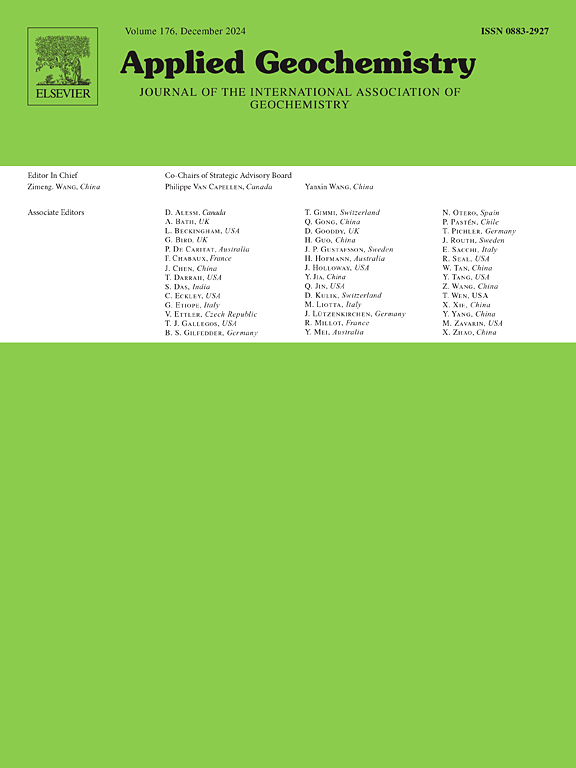通过双同位素和水化学追踪灞河流域地下水-地表水的来源和转化过程
IF 3.1
3区 地球科学
Q1 GEOCHEMISTRY & GEOPHYSICS
引用次数: 0
摘要
地下水和地表水之间的相互作用,包括其补给动态和贡献比例,对水文循环、水资源管理和污染控制至关重要。本研究以灞河流域为研究对象,采用吉布斯图、多元统计分析和 MixSIAR 模型等方法,分析了地下水和地表水的水化学参数和氢氧同位素,定量分析了水体之间的转化关系。结果表明,研究区的地下水和地表水均呈现弱碱性,地下水主要以 HCO3-Ca-Na 为特征,地表水主要以 HCO3-Ca 为特征。此外,地球化学演变主要受岩石风化和阳离子交换过程的影响。地下水和地表水中氢、氧同位素的分布特征表明,大气降水是灞河流域的主要补给来源。根据 MixSIAR 模型,上游地下水对地表水的补给占 90.1%,大气降水占 9.9%。在中游,大气降水和地下水对地表水的贡献率分别为 21.9% 和 78.1%。在下游,地下水对地表水的贡献较大(78.5%),而大气降水对地表水的贡献为 28.5%。这项研究可为了解地下水和地表水的来源和演变提供基础,从而促进地下水资源的有效管理和利用。本文章由计算机程序翻译,如有差异,请以英文原文为准。

Tracing groundwater-surface water sources and transformation processes in the Ba River Basin through dual isotopes and water chemistry
The interactions between groundwater and surface water, including their recharge dynamics and proportional contributions, are crucial for the hydrological cycling, water resource management, and pollution control. This study focused on the Bahe River basin, employing methods such as the Gibbs diagrams, the multivariate statistical analysis, and the MixSIAR model to analyze the hydrochemical parameters and the hydrogen-oxygen isotopes of both groundwater and surface water to quantitatively analyze the transformation relationships between water bodies. The results indicated that both the groundwater and surface water in the research area exhibited weak alkalinity, with the groundwater primarily characterized by HCO3–Ca·Na and surface water predominantly by HCO3–Ca. Furthermore, the geochemical evolution was predominantly affected by the rock weathering and the cation exchange processes. The distribution characteristics of hydrogen and oxygen isotopes in groundwater and surface water suggested that the atmospheric precipitation constituted the main source of recharge in the Bahe River basin. According to the MixSIAR model, the upstream groundwater contributed 90.1% to the surface water, with 9.9% attributed to the atmospheric precipitation. In the midstream, the atmospheric precipitation and groundwater contributed 21.9% and 78.1%, respectively, to the surface water. Downstream, the groundwater contributed significantly to the surface water (78.5%), whereas atmospheric precipitation contributed 28.5%. This study could provide a foundation for understanding the sources and evolution of groundwater and surface water, thereby promoting the effective management and utilization of groundwater resources.
求助全文
通过发布文献求助,成功后即可免费获取论文全文。
去求助
来源期刊

Applied Geochemistry
地学-地球化学与地球物理
CiteScore
6.10
自引率
8.80%
发文量
272
审稿时长
65 days
期刊介绍:
Applied Geochemistry is an international journal devoted to publication of original research papers, rapid research communications and selected review papers in geochemistry and urban geochemistry which have some practical application to an aspect of human endeavour, such as the preservation of the environment, health, waste disposal and the search for resources. Papers on applications of inorganic, organic and isotope geochemistry and geochemical processes are therefore welcome provided they meet the main criterion. Spatial and temporal monitoring case studies are only of interest to our international readership if they present new ideas of broad application.
Topics covered include: (1) Environmental geochemistry (including natural and anthropogenic aspects, and protection and remediation strategies); (2) Hydrogeochemistry (surface and groundwater); (3) Medical (urban) geochemistry; (4) The search for energy resources (in particular unconventional oil and gas or emerging metal resources); (5) Energy exploitation (in particular geothermal energy and CCS); (6) Upgrading of energy and mineral resources where there is a direct geochemical application; and (7) Waste disposal, including nuclear waste disposal.
 求助内容:
求助内容: 应助结果提醒方式:
应助结果提醒方式:


